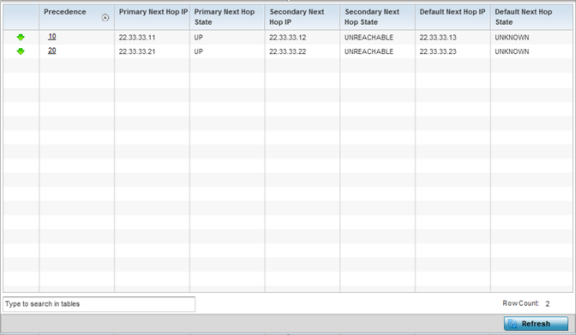AP Policy Based Routing
The Policy Based Routing screen displays statistics for selective PBR (path packet redirection). PBR can optionally mark traffic for preferential services (QoS). PBR is applied to incoming routed packets, and a route-map is generated containing filters and associated redirection actions. Based on the actions defined in the route-map, packets are forwarded to the next relevant hop. Route-maps are configurable under a global policy called routing-policy, and applied to profiles and devices.
To review access point PBR statistics:
- Select the Statistics menu from the Web UI.
- Expand the System node from the navigation pane (on the left-hand side of the screen).
- Expand an RF Domain node, select a controller or service platform, and select one of its connected access points. The access point's statistics menu displays in the right-hand side of the screen, with the Health tab selected by default.
- Select Policy
Based Routing.
 This screen displays the following:
This screen displays the following:Precedence Lists the numeric precedence (priority) assigned to each listed PBR configuration. A route-map consists of multiple entries, each carrying a precedence value. An incoming packet is matched against the route-map with the highest precedence (lowest numerical value).
Primary Next Hop IP Lists the IP address of the virtual resource that, if available, is used with no additional route considerations.
Primary Next Hop State Displays whether the primary hop is applied to incoming routed packets.
Secondary Next Hop IP If the primary hop is unavailable, a second redirection resource is used. This column lists the address set for the alternate route in the election process.
Secondary Next Hop State Displays whether the secondary hop is being applied to incoming routed packets.
Default Next Hop IP If a packet subjected to PBR does not have an explicit route to its destination, the pre-set next hop is used. This is either the IP address of the next hop or the outgoing interface. Only one default next hop is available. The difference between the next hop and the default next-hop is in case of former, PBR occurs first, then destination based routing. In case of the latter, the order is reverse.
Default Next Hop State Displays whether the default hop is being applied to incoming routed packets.
- Select Refresh to update the screen's statistics counters to their latest values.

